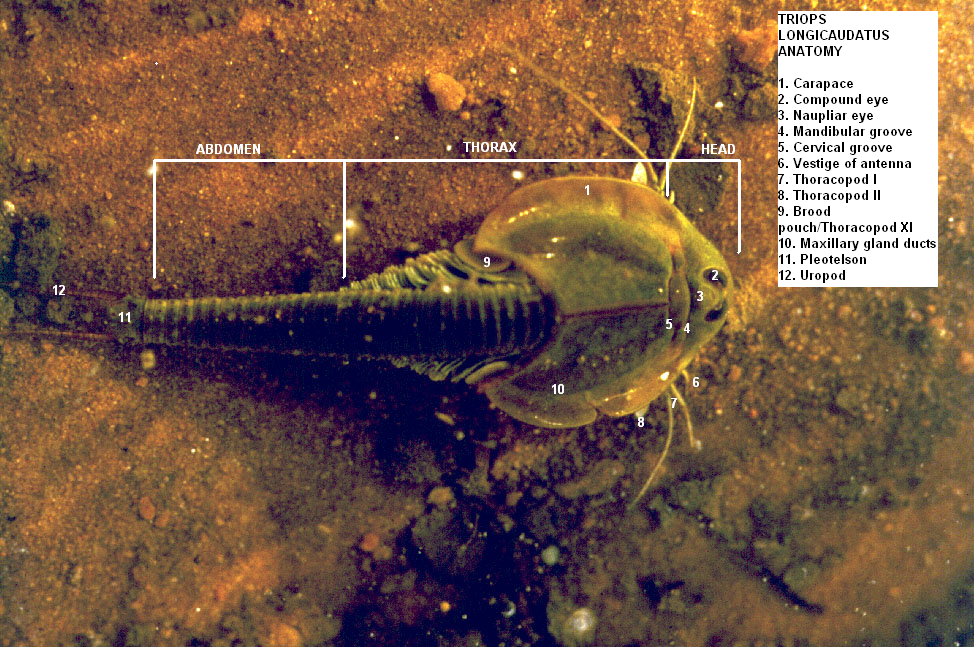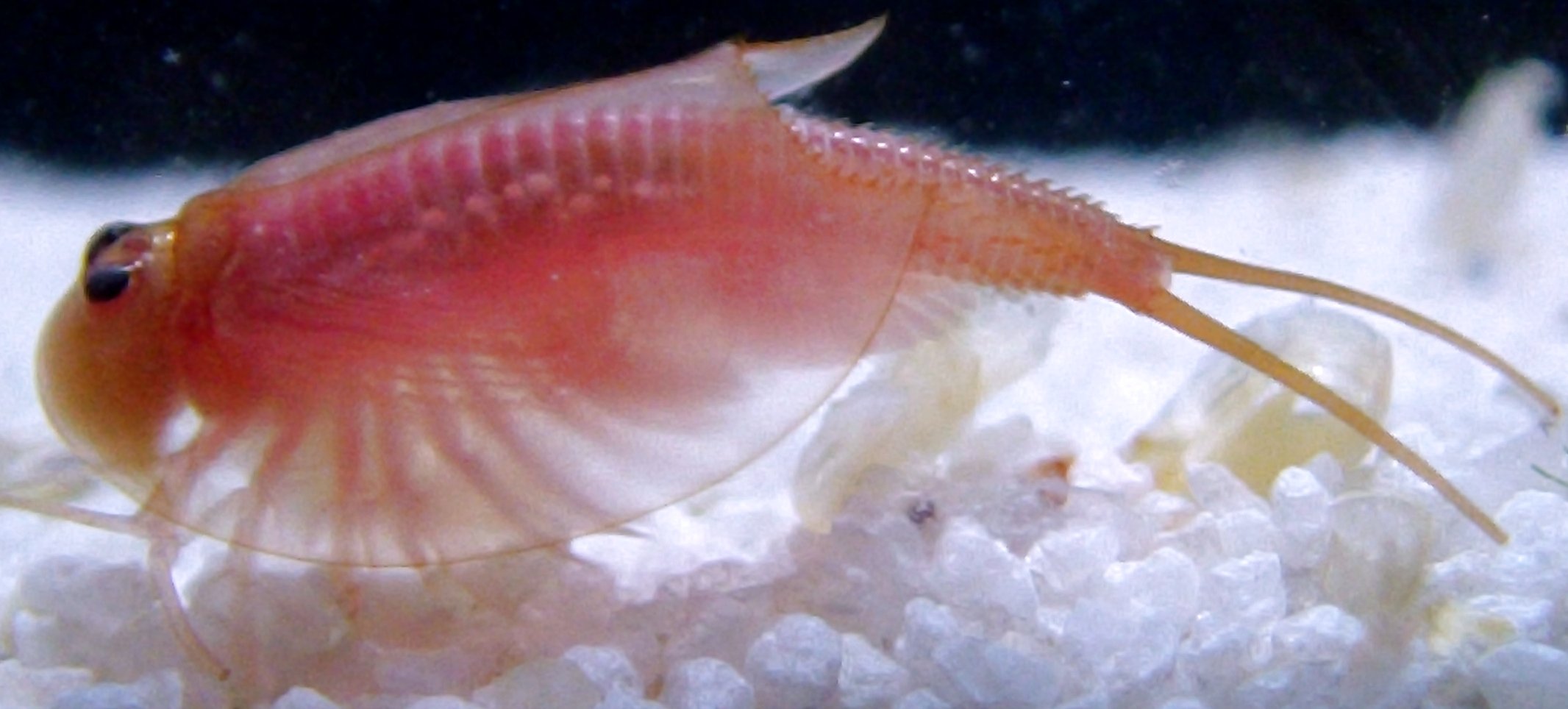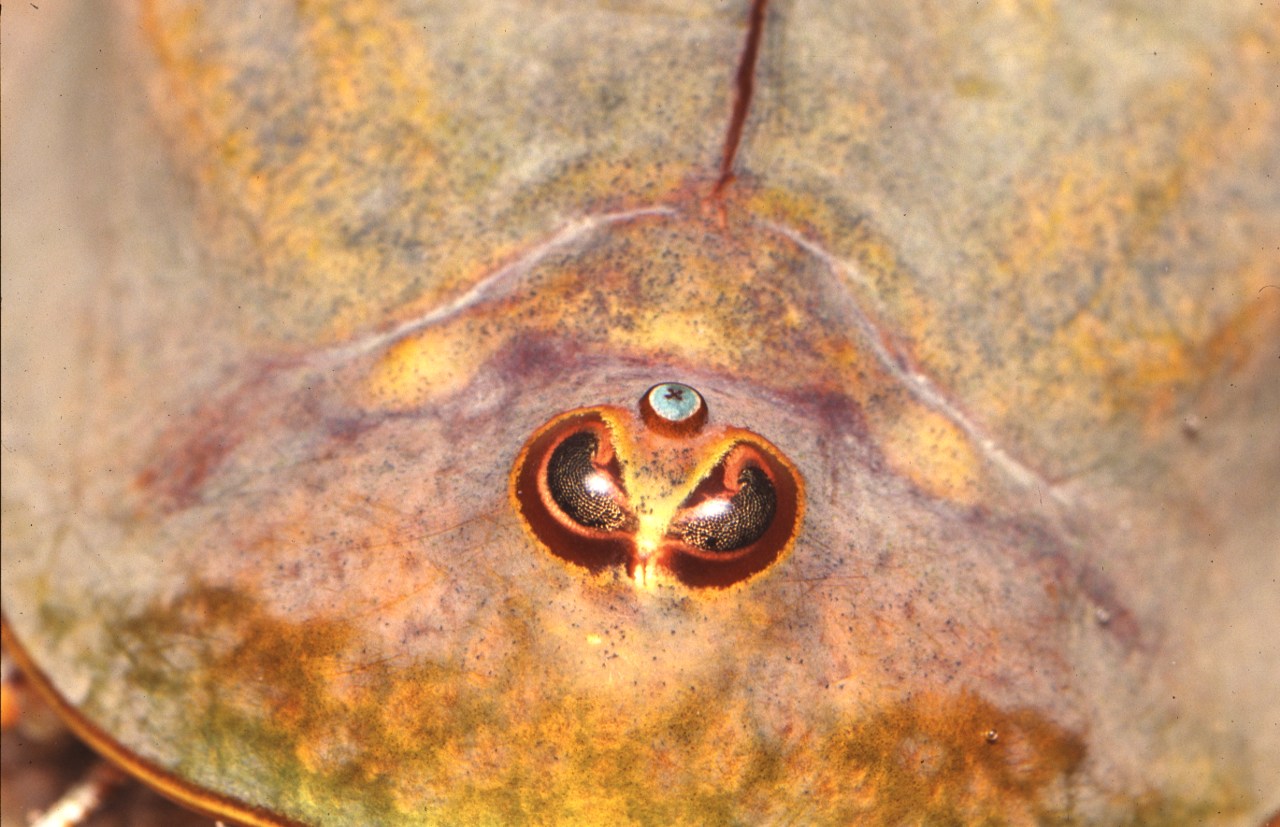|
Triops Longicaudatus
''Triops longicaudatus'' (commonly called American tadpole shrimp or longtail tadpole shrimp) is a freshwater crustacean of the order Notostraca, resembling a miniature horseshoe crab. It is characterized by an elongated, segmented body, a flattened shield-like brownish carapace covering two thirds of the thorax, and two long filaments on the abdomen. The genus name ''Triops'' comes from Ancient Greek ''ὤψ'' or ''ṓps'', meaning "eye" prefixed with Latin ''tri-'', "three", in reference to its three eyes. ''Longicaudatus'' is a Latin neologism combining ''longus'' ("long") and ''caudatus'' ("tailed"), referring to its long tail structures. ''Triops longicaudatus'' is found in freshwater ponds and pools, often in places where few higher forms of life can exist. Classification ''Triops longicaudatus'' is a member of the crustacean class Branchiopoda, which primarily contains freshwater animals with gills on their legs. The class Branchiopoda is divided into the subclasses Sarsost ... [...More Info...] [...Related Items...] OR: [Wikipedia] [Google] [Baidu] |
John Lawrence LeConte
John Lawrence LeConte (May 13, 1825 – November 15, 1883) was an American entomologist of the 19th century, responsible for naming and describing approximately half of the insect taxa known in the United States during his lifetime,Bird Name Biographies - URL retrieved September 14, 2006 including some 5,000 of beetles. He was recognized as the foremost authority on North American s during his lifetime, and has been described as "the father of American beetle study".Evans, Arthur V., and James N. Hogue. 2004. Chapter 1: A Brief History of Beetle Study in California. ''I ... [...More Info...] [...Related Items...] OR: [Wikipedia] [Google] [Baidu] |
Triops Cancriformis
''Triops cancriformis'', European tadpole shrimp or tadpole shrimp, is a species of tadpole shrimp found in Europe to the Middle East and India. Due to habitat destruction, many populations have recently been lost across its European range, so, the species is considered endangered in the United Kingdom and in several European countries. In captivity they commonly grow up to ; in the wild they can achieve sizes of . In the UK, there are just two known populations: in a pool and adjacent area in the Caerlaverock Wetlands in Scotland, and a temporary pond in the New Forest. The species is legally protected under Schedule 5 of the Wildlife and Countryside Act 1981 (as amended). Fossils from the Upper Triassic ( Norian) of Germany, around 237 million years old have been attributed to this species as the subspecies ''T. cancriformis minor'', due to their great similarity to modern day members of the species. However, later research showed that their ontogenetic growth was quite di ... [...More Info...] [...Related Items...] OR: [Wikipedia] [Google] [Baidu] |
Dorsum (biology)
Standard anatomical terms of location are used to unambiguously describe the anatomy of animals, including humans. The terms, typically derived from Latin or Greek language, Greek roots, describe something in its standard anatomical position. This position provides a definition of what is at the front ("anterior"), behind ("posterior") and so on. As part of defining and describing terms, the body is described through the use of anatomical planes and anatomical axis, anatomical axes. The meaning of terms that are used can change depending on whether an organism is bipedal or quadrupedal. Additionally, for some animals such as invertebrates, some terms may not have any meaning at all; for example, an animal that is radially symmetrical will have no anterior surface, but can still have a description that a part is close to the middle ("proximal") or further from the middle ("distal"). International organisations have determined vocabularies that are often used as standard vocabular ... [...More Info...] [...Related Items...] OR: [Wikipedia] [Google] [Baidu] |
Cephalothorax
The cephalothorax, also called prosoma in some groups, is a tagma of various arthropods, comprising the head and the thorax fused together, as distinct from the abdomen behind. (The terms ''prosoma'' and ''opisthosoma'' are equivalent to ''cephalothorax'' and ''abdomen'' in some groups.) The word ''cephalothorax'' is derived from the Greek words for head (, ') and thorax (, '). This fusion of the head and thorax is seen in chelicerates and crustaceans; in other groups, such as the Hexapoda (including insects), the head remains free of the thorax. In horseshoe crabs and many crustaceans, a hard shell called the carapace covers the cephalothorax. Arachnid anatomy Fovea The fovea is the centre of the cephalothorax and is located behind the head (only in spiders).Dalton, Steve (2008). ''Spiders; The Ultimate Predators''. A & C Black, London. P.p. 19. . It is often important in identification. It can be transverse or procurved Smith, A. M. (1990c). Baboon spiders: Tarantulas of Afri ... [...More Info...] [...Related Items...] OR: [Wikipedia] [Google] [Baidu] |
Lander University
Lander University is a public university in Greenwood, South Carolina. Campus and housing Lander University is located approximately one half-mile from uptown Greenwood, South Carolina. The main campus sits on 190 acres of land, though this does not include its many off-campus locations. Lander University has ten residence halls. Residence halls include Bearcat Village, Brookside, Centennial Hall, Chipley Hall, Lide Apartments, McGhee Court, New Hall, Thomason, University Place, and Williamston. In July 2021, Lander announced that the state legislature has appropriated new funding for the University, which includes money that will be used to construct a nursing building on Lander's campus in Greenwood. Rankings In the 2018 edition of '' U.S. News & World Report''s ''Best Colleges'' rankings, Lander ranked 29 in Regional Colleges of the South and 6 in Best Colleges for Veterans. Faculty Lander has 178 full-time faculty members. Academics More than 90 areas of undergraduate an ... [...More Info...] [...Related Items...] OR: [Wikipedia] [Google] [Baidu] |
Millipede
Millipedes are a group of arthropods that are characterised by having two pairs of jointed legs on most body segments; they are known scientifically as the class Diplopoda, the name derived from this feature. Each double-legged segment is a result of two single segments fused together. Most millipedes have very elongated cylindrical or flattened bodies with more than 20 segments, while pill millipedes are shorter and can roll into a tight ball. Although the name "millipede" derives from the Latin for "thousand feet", no species was known to have 1,000 or more until the discovery of ''Eumillipes persephone'', which can have over 1,300 legs. There are approximately 12,000 named species classified into 16 orders and around 140 families, making Diplopoda the largest class of myriapods, an arthropod group which also includes centipedes and other multi-legged creatures. Most millipedes are slow-moving detritivores, eating decaying leaves and other dead plant matter. Some eat fungi or ... [...More Info...] [...Related Items...] OR: [Wikipedia] [Google] [Baidu] |
Abdomen
The abdomen (colloquially called the belly, tummy, midriff, tucky or stomach) is the part of the body between the thorax (chest) and pelvis, in humans and in other vertebrates. The abdomen is the front part of the abdominal segment of the torso. The area occupied by the abdomen is called the abdominal cavity. In arthropods it is the posterior (anatomy), posterior tagma (biology), tagma of the body; it follows the thorax or cephalothorax. In humans, the abdomen stretches from the thorax at the thoracic diaphragm to the pelvis at the pelvic brim. The pelvic brim stretches from the lumbosacral joint (the intervertebral disc between Lumbar vertebrae, L5 and Vertebra#Sacrum, S1) to the pubic symphysis and is the edge of the pelvic inlet. The space above this inlet and under the thoracic diaphragm is termed the abdominal cavity. The boundary of the abdominal cavity is the abdominal wall in the front and the peritoneal surface at the rear. In vertebrates, the abdomen is a large body c ... [...More Info...] [...Related Items...] OR: [Wikipedia] [Google] [Baidu] |
Thorax
The thorax or chest is a part of the anatomy of humans, mammals, and other tetrapod animals located between the neck and the abdomen. In insects, crustaceans, and the extinct trilobites, the thorax is one of the three main divisions of the creature's body, each of which is in turn composed of multiple segments. The human thorax includes the thoracic cavity and the thoracic wall. It contains organs including the heart, lungs, and thymus gland, as well as muscles and various other internal structures. Many diseases may affect the chest, and one of the most common symptoms is chest pain. Etymology The word thorax comes from the Greek θώραξ ''thorax'' "breastplate, cuirass, corslet" via la, thorax. Plural: ''thoraces'' or ''thoraxes''. Human thorax Structure In humans and other hominids, the thorax is the chest region of the body between the neck and the abdomen, along with its internal organs and other contents. It is mostly protected and supported by the rib cage, spi ... [...More Info...] [...Related Items...] OR: [Wikipedia] [Google] [Baidu] |
Appendage
An appendage (or outgrowth) is an external body part, or natural prolongation, that protrudes from an organism's body. In arthropods, an appendage refers to any of the homologous body parts that may extend from a body segment, including antennae, mouthparts (including mandibles, maxillae and maxillipeds), gills, locomotor legs ( pereiopods for walking, and pleopods for swimming), sexual organs (gonopods), and parts of the tail (uropods). Typically, each body segment carries one pair of appendages. An appendage which is modified to assist in feeding is known as a maxilliped or gnathopod. In vertebrates, an appendage can refer to a locomotor part such as a tail, fins on a fish, limbs (legs, flippers or wings) on a tetrapod; exposed sex organ; defensive parts such as horns and antlers; or sensory organs such as auricles, proboscis ( trunk and snout) and barbels. Appendages may become ''uniramous'', as in insects and centipedes, where each appendage comprises a single ... [...More Info...] [...Related Items...] OR: [Wikipedia] [Google] [Baidu] |
Triops Anatomy New
''Triops'' is a genus of small crustaceans in the order Notostraca (tadpole shrimp). The long-lasting resting eggs of several species of ''Triops'' are commonly sold in kits as a pet. The animals hatch upon contact with fresh water. Most adult-stage ''Triops'' have a life expectancy of up to 90 days and can tolerate a pH range of 6–10. In nature, they often inhabit temporary pools. Relatives and fossil record The genus ''Triops'' can be distinguished from the only other living genus of Notostraca, '' Lepidurus'', by the form of the telson (the end of its 'tail'), which bears only a pair of long, thin caudal extensions in ''Triops'', while ''Lepidurus'' also bears a central platelike process. Only 24 hours after hatching they already resemble miniature versions of the adult form. ''Triops'' are sometimes called "living fossils", since fossils that have been attributed to this genus have been found in rocks hundreds of millions of years old. However, careful analysis of these ... [...More Info...] [...Related Items...] OR: [Wikipedia] [Google] [Baidu] |
Cercopod
Cerci (singular cercus) are paired appendages on the rear-most segments of many arthropods, including insects and symphylans. Many forms of cerci serve as sensory organs, but some serve as pinching weapons or as organs of copulation. In many insects, they simply may be functionless vestigial structures. In basal arthropods, such as silverfish, the cerci originate from the eleventh abdominal segment. As segment eleven is reduced or absent in the majority of arthropods, in such cases, the cerci emerge from the tenth abdominal segment. It is not clear that other structures so named are homologous. In the Symphyla they are associated with spinnerets. Morphology and functions Most cerci are segmented and jointed, or filiform (threadlike), but some take very different forms. Some Diplura, in particular ''Japyx'' species, have large, stout forcipate (pincer-like) cerci that they use in capturing their prey. The Dermaptera, or earwigs, are well known for the forcipate cerci that mo ... [...More Info...] [...Related Items...] OR: [Wikipedia] [Google] [Baidu] |



.jpg)





